Heat Hazards in High-Temperature Tunnels: Influencing Factors, Disaster Forms, the Geogenetic Model and a Case Study of a Tunnel in Southwest China
Abstract
1. Introduction
- Which geological factors may influence geotemperature and how do they affect the rock temperature?
- What are the main disaster forms and geogenetic modes of high-temperature heat hazards?
- What are the countermeasures for high-temperature heat hazards?
2. Factors Influencing the Geotemperature Field
- The deep geothermal background reflected by regional geothermal heat flow,
- Spatial variations in heat transfer conditions caused by the heterogeneity of the geological structure, and
- The presence or absence of local additional heat sources and their scale and intensity.
2.1. The Influence of the Deep Geothermal Background Reflected by Regional Geothermal Heat Flow
2.2. The Influence of Spatial Variations in Heat Transfer Conditions Caused by the Heterogeneity of the Geological Structure
- (1)
- The heterogeneity of rock thermophysical properties: The vertical distribution of the geothermal field is significantly influenced by the varying thermal conductivities of rock strata. Strata with low thermal conductivity often serve as thermal insulation cover. According to the principle of heat flow conservation within the Earth, when there are no additional heat sources, the heat flow value within each rock section of the same borehole is consistent. Consequently, the product of the geothermal gradient within each section of the borehole and the thermal conductivity of the rock is a constant. The geothermal gradient and thermal conductivity of each rock formation are in a reciprocal relationship. As a result, in rock formations characterized by low thermal conductivity, the geothermal gradient increases, resulting in the phenomenon known as localized heat accumulation.
- (2)
- The heterogeneity of the geological structure: The geological structure plays a pivotal role in shaping the distribution of heat flow, consequently impacting the distribution of the geotemperature field (Figure 2). For instance, positive geological tectonic units, such as bedrock uplift areas, anticlinal structure, and crystalline rock zones with high thermal conductivity, exhibit low thermal resistance relative to neighboring surroundings. This facilitates the concentration of geothermal heat flow, resulting in localized heat accumulation. Negative geological tectonic units such as bedrock depression areas, syncline structure, and fault zone descending plates exhibit high thermal resistance relative to neighboring surroundings. This facilitates the dispersion of geothermal heat flow.
2.3. The Influence of the Presence or Absence of Local Additional Heat Sources and Their Scale and Intensity
- (1)
- Groundwater, with its substantial specific heat capacity and high fluidity, stands out as the most influential thermogenic factor, playing a pivotal role in shaping the geothermal field [8]. Vertical groundwater movement exerts a considerably more significant impact on the geothermal field than horizontal movement. In the vertical motion of groundwater, the upward flow of relatively high-temperature water acts as a localized positive heat source, while the downward flow of lower-temperature water represents a negative heat source (Figure 3). The magnitude of geothermal field anomalies induced by groundwater activity correlates with several factors, including the water circulation depth, its flow velocity, and the temperature differential between the water and the surrounding rock.
- (2)
- The presence of radioactive heat-producing elements in rocks can act as an additional heat source. It is a well-established fact that various types of rocks contain trace amounts of radioactive heat-producing elements such as uranium, thorium, and potassium. However, the concentrations of these elements are typically quite low. Consequently, within the limited depth and thickness range of rocks, the heat generation from radioactive elements does not exert a significant influence on the temperature field. In unique geological settings, some rock formations exhibit substantially higher levels of radioactivity. In specific regions like the Mesozoic volcanic basins of south-central China, the acidic volcanic rock layers display elevated radioactivity heat production.
3. The Disaster Forms and Geogenetic Model of Heat Hazards
3.1. Classification of Disaster Forms of High-Temperature Heat Hazards
- (1)
- Inducing high temperature and humidity levels within tunnels: High geotemperatures can result in an increase in temperature and humidity levels within tunnels [18]. This, in turn, can lead to reduced labor efficiency, adverse impacts on the physical and mental health of workers [19], and an elevated risk of machinery and equipment failures.
- (2)
- Exacerbating deformation and damage to tunnel surrounding rock: High geotemperatures have the potential to worsen the deformation of soft rock, affecting the rock explosion process in hard rock, consequently increasing safety risks associated with blasting operations.
- (3)
- Triggering failures in tunnel support structures: The high-geotemperature environment may reduce the anchoring force of anchor rods (ropes), deteriorate the mechanical properties of concrete (Figure 4b), and even lead to lining cracking.
- (4)
- Augmenting safety risks in projects: High geotemperatures can heighten the risk of incidents such as hot water inrushes (Figure 4a), gas explosions, landslides, and other accidents.
3.2. Geogenetic Models of High-Temperature Heat Hazards
4. Case Study
4.1. Engineering Description
4.2. Analysis of the Geological Causes of Heat Hazards
4.3. Prediction, Prevention and Control of High-Temperature Heat Hazards
5. Lessons Learned and Discussion
5.1. Lessons Learned
- The localized additional heat source, arising from groundwater circulation, significantly impacts the temperature distribution in the Earth’s crust. This influence is primarily expressed through two key processes: heat conduction and heat convection, which are, respectively, manifested as ultra-high rock temperature and high-temperature hot water within the context of the tunnel project.
- The geothermal gradient attributed to groundwater circulation in this region surpasses the Earth’s average geothermal gradient. In some areas, this gradient is several times higher, leading to a pronounced issue of high geotemperatures. For example, the highest recorded water temperature in this tunnel reaches 93.5 °C, while the highest rock temperature attains 77 °C.
- The existence of high-temperature hot water (greater than 80 °C in this tunnel) significantly impacts the consolidation process of grouting materials. Conventional grouting materials are susceptible to failure under these conditions.
- Owing to the heat conduction effect, the groundwater circulation, serving as an additional heat source, engenders a broader spectrum of heat effects. The tunnel heat hazard area is influenced by temperature conditions over a wide geographical range.
5.2. Countermeasures for High-Temperature Heat Hazard Prevention and Control
5.2.1. Stage of Geological Investigation
- (1)
- Regional geothermal environment investigation: During the investigation and planning of underground engineering, the prediction of high geothermal temperature issues can be obtained by inquiring pertinent data pertaining to the distribution of geothermal resources within the project area.
- (2)
- Hot springs examination: The presence of hot springs, particularly those of high temperatures, often signals the potential existence of geothermal resources in the project area, potentially posing challenges related to high geothermal temperatures. Investigating the causes of hot springs within the project’s scope, including an analysis of water temperature, water quality, the local tectonic environment, hydrogeological conditions, and the correlation between hot springs and the groundwater system’s chemical composition, is crucial to determine whether high geothermal temperatures could pose issues at the project site.
- (3)
- Geothermal parameters assessment: This involves the determination of constant temperature depth and its corresponding temperature, as well as the geothermal gradient, which represents the increase in rock temperature per 100 m of depth. These parameters serve as critical foundational data for analyzing the geothermal field in underground engineering. Therefore, comprehensively understanding the geothermal parameters in the region, through advanced logging techniques, is essential for predicting and addressing potential high geothermal challenges.
- (4)
- Identification of exposed high geothermal temperature forms: By considering regional structural characteristics, rock conditions, groundwater recharge and discharge patterns, and the relationship between the elevation of hot springs and the tunnel’s alignment, a preliminary assessment of the exposed forms of high geothermal temperatures at the project site can be made. This enables informed decision-making in the selection of construction measures and design schemes.
5.2.2. Stage of Tunnel Excavation
- (1)
- Data collection: Collect high-temperature heat hazard data, topography and geomorphology, stratigraphic lithology, geological structure, hydrogeology, the type of surrounding rock, and on-site geological records.
- (2)
- Surface exploration: Surface exploration methods are employed to conduct extensive investigations along the tunnel’s alignment. Based on the outcomes of surface exploration, borehole temperature measurements are conducted to ascertain temperature profiles at various depths within the tunnel. The borehole results are compared with those obtained from surface exploration, and a systematic classification of high-temperature segments is carried out.
- (3)
- Tunnel geological forecast: Geophysical prospecting techniques within the tunnel are adopted to detect the temperature distributions and water content in front of the tunnel. This aids in the analysis and prediction of the geological conditions ahead of the tunnel’s construction. Building upon the findings of the physical exploration, borehole temperature measurements are executed to corroborate and complement the geophysical results. Finally, the classification of high-temperature heat hazard types, their spatial distribution, water content levels, and heat damage severity are analyzed and judged comprehensively.
- (1)
- Ventilation optimization: Ventilation stands as a primary and widely employed cooling measure in preventing and mitigating heat hazards. When heat hazard levels are relatively low, optimization of the ventilation system and methods, among other strategies, proves effective in managing the situation.
- (2)
- Thermal insulation technology: High-rock-temperature tunnels demand the development of novel high-temperature-resistant thermal insulation materials, building upon existing thermal insulation technology. Furthermore, exploring more effective ways of laying thermal insulation layers is also necessary.
- (3)
- Water insulation technology: Hydrothermal high-temperature tunnels present a unique challenge, given the combined influence of ultra-high-temperature rock and high-temperature fissure water. On the basis of the heat insulation technology, it is essential to research and develop innovative, high-temperature-resistant, and corrosion-resistant water-insulating materials. These materials should be combined with high-temperature fissure water diversion and sealing measures.
- (4)
- Moisture and heat control technology: For extreme-temperature and -humidity environments, it is necessary to give full consideration to the respective advantages of the existing artificial and non-artificial cooling technology, and a variety of technologies work together.
6. Conclusions
- (1)
- The deep geothermal background, heat conduction conditions, and local additional heat sources are the most important factors influencing the geothermal field. Among them, additional heat sources, especially underground hot water circulation, cause more harm.
- (2)
- The tunnel hazards caused by high geothermal temperatures are divided into four categories: causing a hot and humid environment inside the tunnel, aggravating the deformation and damage of tunnel surrounding rock, inducing the failure of tunnel supporting structure, and increasing the safety risk of the project.
- (3)
- Three types and six subtypes of high-temperature thermal hazard causation models were proposed. Notably, the subtype involving underground hot water circulation in the shallow Earth’s crust is identified as the most deleterious.
- (4)
- A case study of high-temperature thermal hazards in a southwestern Chinese tunnel is meticulously presented. The amalgamation of comprehensive geophysical exploration and surface geological survey emerges as an effective methodology for acquiring and evaluating detailed geological conditions. For the assurance of tunnel excavation safety in the region, specific measures for forecasting and preventing high-temperature thermal damage in tunnels are advocated.
- (5)
- Proposed countermeasures for addressing high-temperature heat hazards in actual projects are delineated for two stages of tunnel construction: the geological investigation stage and the construction stage.
- (6)
- The insights gained from our research have a certain degree of relevance and applicability to tunnels in other parts of the world. The fundamental principles and methods we employed in our investigation can serve as a valuable foundation for understanding and addressing similar challenges in different tunnel environments.
Author Contributions
Funding
Institutional Review Board Statement
Informed Consent Statement
Data Availability Statement
Conflicts of Interest
References
- Li, L.; Wang, Q.; Li, S.; Huang, H.; Shi, S.; Kang, W.; Lei, T.; Chen, D. Cause analysis of soft and hard rock tunnel collapse and information management. Pol. J. Environ. Stud. 2014, 23, 1227–1233. [Google Scholar]
- Wu, G.; Chen, W.; Yuan, J.; Yang, D.; Bian, H. Formation mechanisms of water inrush and mud burst in a migmatite tunnel: A case study in china. J. Mt. Sci. 2017, 14, 188–195. [Google Scholar] [CrossRef]
- Xiong, Z.; Wang, M.; Shi, S.; Xia, Y.; Lu, H.; Bu, L. Water inrush analysis of the longmen mountain tunnel based on a 3d simulation of the discrete fracture network. Open Geosci. 2017, 9, 650–662. [Google Scholar] [CrossRef]
- Huang, X.; Li, S.; Xu, Z.; Guo, M.; Chen, Y. Assessment of a concealed karst cave’s influence on karst tunnel stability: A case study of the huaguoshan tunnel, China. Sustainability 2018, 10, 2132. [Google Scholar] [CrossRef]
- Chang, S.; Chen, C.; Wang, T. Sediment sluice tunnel of zengwen reservoir and construction of section with huge underground excavation adjacent to neighboring slope-sciencedirect. Eng. Geol. 2019, 260, 105227. [Google Scholar] [CrossRef]
- Dong, L.; Chen, J.; Song, D.; Wang, C.; Liu, X.; Liu, M.; Wang, E. Application of Long-Range Cross-Hole Acoustic Wave Detection Technology in Geotechnical Engineering Detection: Case Studies of Tunnel-Surrounding Rock, Foundation and Subgrade. Sustainability 2022, 14, 16947. [Google Scholar] [CrossRef]
- Meng, G.; Li, H.; Wu, B.; Liu, G.; Ye, H.; Zuo, Y. Prediction of the Tunnel Collapse Probability Using SVR-Based Monte Carlo Simulation: A Case Study. Sustainability 2023, 15, 7098. [Google Scholar] [CrossRef]
- Zhou, Y.; Mu, G.X.; Zhang, H.; Wang, K.; Liu, J.Q.; Zhang, Y.G. Geothermal field division and its geological influencing factors in Guanzhong basin. Geol. China 2017, 44, 1017–1026. [Google Scholar]
- Duan, L.; Zhang, Y.; Lai, J. Influence of ground temperature on shotcrete-to-rock adhesion in tunnels. Adv. Mater. Sci. Eng. 2019, 2019, 8709087. [Google Scholar] [CrossRef]
- Feng, T.; Jiang, L.W.; Zhang, G.Z.; Wang, D. Discussion about estimation techinique of tunnel thermal harm in ya’an-kangding section of the sichuan-iibet railway. J. Railw. Eng. Soc. 2016, 5, 11–17. [Google Scholar]
- Zeng, Y.; Tao, L.; Ye, X.; Zhou, X.; Fang, Y.; Fan, L.; Liu, X.; Yang, Z. Temperature reduction for extra-long railway tunnel with high geotemperature by longitudinal ventilation. Tunn. Undergr. Space Technol. 2020, 99, 103381. [Google Scholar] [CrossRef]
- Lin, M.; Zhou, P.; Jiang, Y.; Zhou, F.; Lin, J.; Wang, Z. Numerical investigation on comprehensive control system of cooling and heat insulation for high geothermal tunnel: A case study on the highway tunnel with the highest temperature in china. Int. J. Therm. Sci. 2022, 173, 107385. [Google Scholar] [CrossRef]
- He, P.; Zhang, G.Z.; Qiang, X.G. Cause analysis of geothermal water and geological route selection research on the Sangzhuling tunnel of Sichuan—Tibet Railway. J. Railw. Eng. Soc. 2020, 37, 10–13. [Google Scholar]
- Li, Y.N. Geophysical Prospecting Techniques for Geothermal Prediction in the Jiwoxiga Tunnel. Railw. Constr. Technol. 2015, 10, 1–4. [Google Scholar]
- Yao, X.C.; Li, N.; Yu, C.H.; Guo, Y. Filed test of temperature field of the surrounding rocks of high temperature in the Gonggerer diversion tunnel in Xinjiang. Hydrogeol. Eng. Geol. 2018, 45, 59–66. [Google Scholar]
- Fan, L. Study on the Key Techniques for Comprehensive Control of Heat Harm of the Deep-buried and Super-long Tunnel with High Ground Temperature. Mod. Tunn. Technol. 2019, 56, 1–10. [Google Scholar]
- Guo, P.Y.; Bu, M.H.; Zhang, P.; Li, Q.B.; He, M.C. Review on catastrophe mechanism and disaster countermeasure of high geotemperature tunnel. Chin. J. Rock. Mech. Eng. 2023, 42, 1561–1581. [Google Scholar]
- Wu, Q.G.; Wang, J.Z. Study on thermal insulation layer of high ground temperature railway tunnel. J. Railway Sci. Eng. 2017, 14, 1715–1726. [Google Scholar]
- Hu, Y.; Wang, M.; Wang, Q.; Liu, D.; Tong, J. Field test of thermal environment and thermal adaptation of workers in high geothermal tunnel. Build. Environ. 2019, 160, 106–174. [Google Scholar]
- Tang, Y.; Xu, G.; Lian, J.; Su, H.; Qu, C. Effect of temperature and humidity on the adhesion strength and damage mechanism of shotcrete-surrounded rock. Constr. Build. Mater. 2016, 124, 1109–1119. [Google Scholar] [CrossRef]
- Yu, P. Research on the high ground temperature risk during long tunnel construction. In Proceedings of the International Conference on Advances in Energy, Environment and Chemical Engineering, Changsha, China, 26–27 September 2015; pp. 584–587. [Google Scholar]
- Wang, M.; Hu, Y.; Liu, D.; Jiang, C.; Wang, Q.; Wang, Y. A study on the heat transfer of surrounding rock-supporting structures in high-geothermal tunnels. Appl. Sci. 2020, 10, 2307. [Google Scholar] [CrossRef]
- Zhou, X.; Zeng, Y.; Yang, Z.; Zhou, X. Numerical solution of the heat transfer between tunnels and rocks in high-temperature geothermal region. J. Railway Sci. Eng. 2015, 12, 1406–1411. [Google Scholar]
- Mo, Z.G.; Jiang, H.B.; Hou, X.B. 3-D numerical simulation analysis on temperature field of tunnel under high. Water Resour. Hydropower Eng. 2015, 48, 57–60. [Google Scholar]
- Liu, Z.Y. Experimental study on the formulation of shotcrete materials in high temperature and high humidity environment. Sci. Technol. West. China 2008, 7, 1–3. [Google Scholar]
- Tan, X.; Chen, W.; Yang, D.; Dai, Y.; Wu, G.; Yang, J. Study on the influence of air flow on the temperature of the surrounding rock in a cold region tunnel and its application to insulation layer design. Appl. Therm. Eng. 2014, 67, 320–334. [Google Scholar] [CrossRef]
- Mainali, G.; Dineva, S.; Nordlund, E. Experimental study on debonding of shotcrete with acoustic emission during freezing and thawing cycle. Cold Reg. Sci. Technol. 2015, 111, 1–12. [Google Scholar] [CrossRef]
- Prashantk, J.; Suneet, S.; Rizwan, U. Analytical solution to transient asymmetric heat conduction in a multilayer annulus. J. Heat Transfer. 2009, 1, 73–92. [Google Scholar]
- Villagrán, E.; Flores-Velazquez, J.; Akrami, M.; Bojacá, C. Influence of the Height in a Colombian Multi-Tunnel Greenhouse on Natural Ventilation and Thermal Behavior: Modeling Approach. Sustainability 2021, 13, 13631. [Google Scholar] [CrossRef]
- Shen, L.L. Preliminary Research on the Geothermal Abnormalism and Its Impact on the Tunnel Construction in the District of Gaoligong Mountain. Master’s Thesis, Chengdu University of Technology, Chengdu, China, 2007. [Google Scholar]
- Wang, D. Formation Mechanism of Thermal Groundwater and Characteristics of Geothermal Field in Gaoligongshan Section of Dali-Ruili Railway. Master’s Thesis, Chengdu University of Technology, Chengdu, China, 2011. [Google Scholar]
- Li, G.W.; Du, Y.B.; Jiang, L.W.; Guo, C.B.; Shen, W.; Liu, X.Y. Research on the engineering geology condition and railway routes comparison along the Mt. Gaoligong Section, Dali-Ruili railway. J. Geomech. 2015, 21, 73–86. [Google Scholar]
- Hu, Z.; Tian, M.Z.; Guo, W.X.; Liu, J.Y. Geological Genesis of Tunnel High Ground Temperature. J. Southwest. Jiaotong Univ. 2022, 57, 1077–1112. [Google Scholar]
- Zhao, G.B.; Xu, X.Y.; Liu, S.P. Phenomenon and cause of high geo-temperature of hydroelectric power diversion tunnel in kala-kunlun mountain. J. Eng. Geol. 2015, 23, 1196–1201. [Google Scholar]
- Wang, X.N.; Huang, R.Q.; Huang, G.M. Analysis of effects of ground water on geotemperature anomaly in deeply-lying long and big tunnel. J. Geol. Hazards Environ. Prot. 1996, 7, 23–27. [Google Scholar]
- Gu, B.S. Countermeasures against high temperatures in a tunnel and the corresponding ventilation design--Feasibility study for the super-long Gaoligonshan tunnel. Mod. Tunn. Technol. 2007, 2, 66–71. [Google Scholar]
- Xie, S.Q. Technology of tunneling under the geological conditions of high ground temperature on the Pamirs plateau. Northwest Hydropower 2010, 5, 42–44. [Google Scholar]

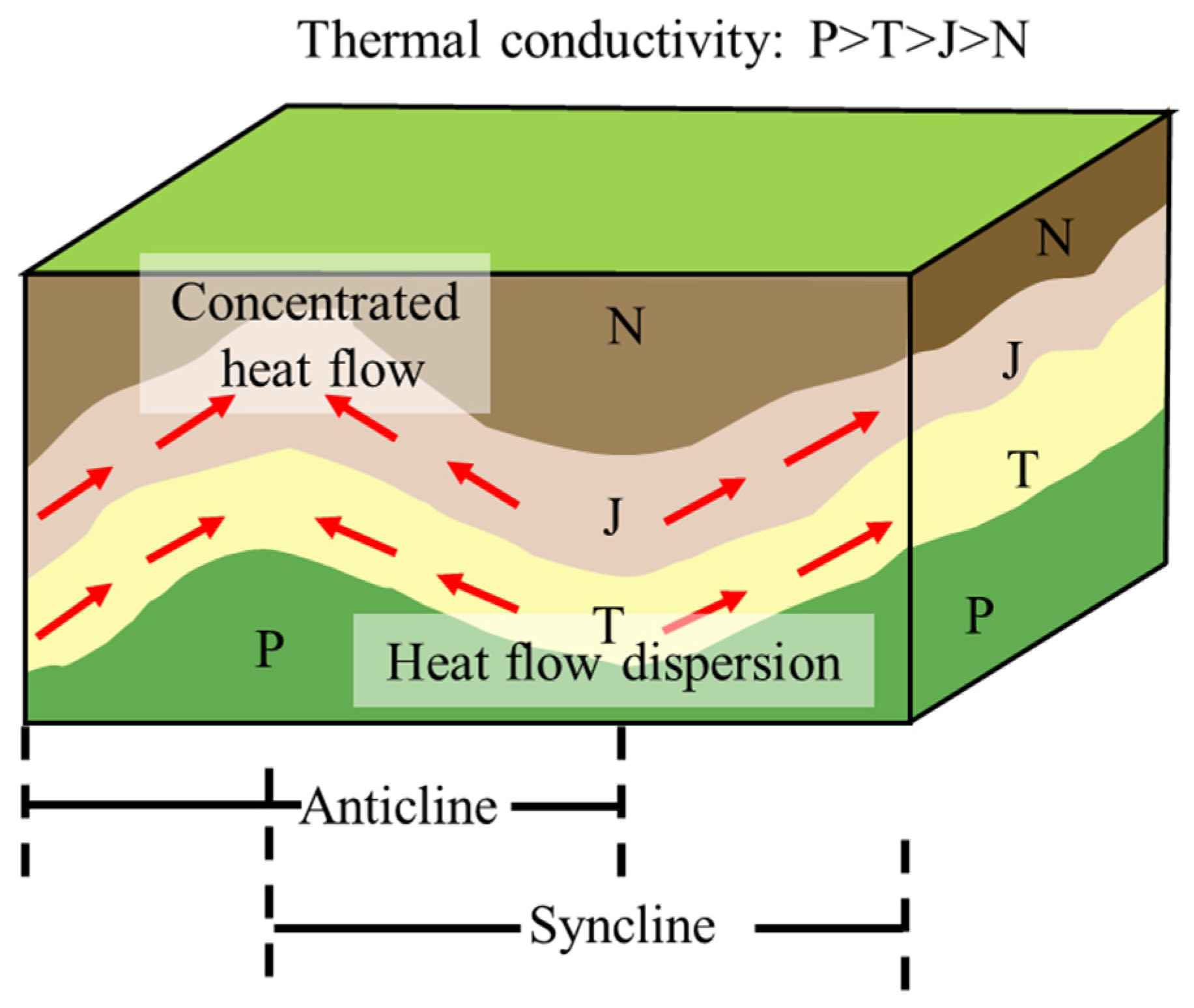

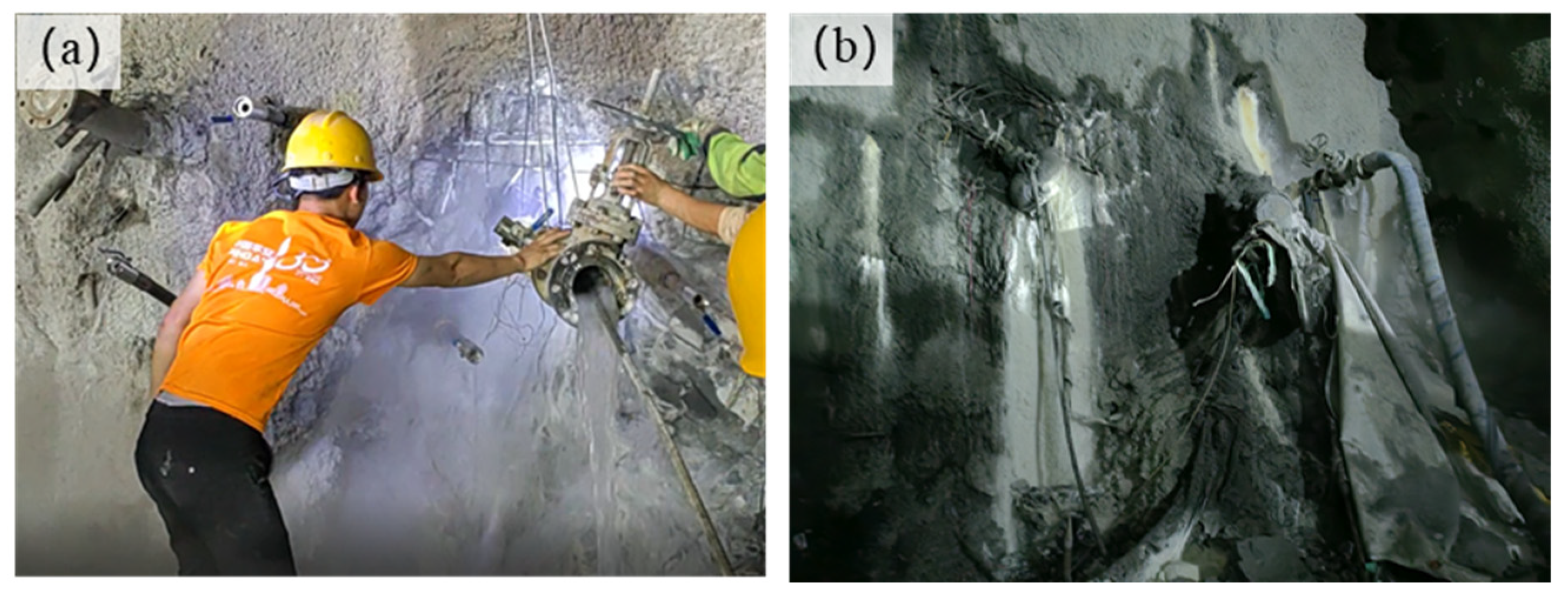
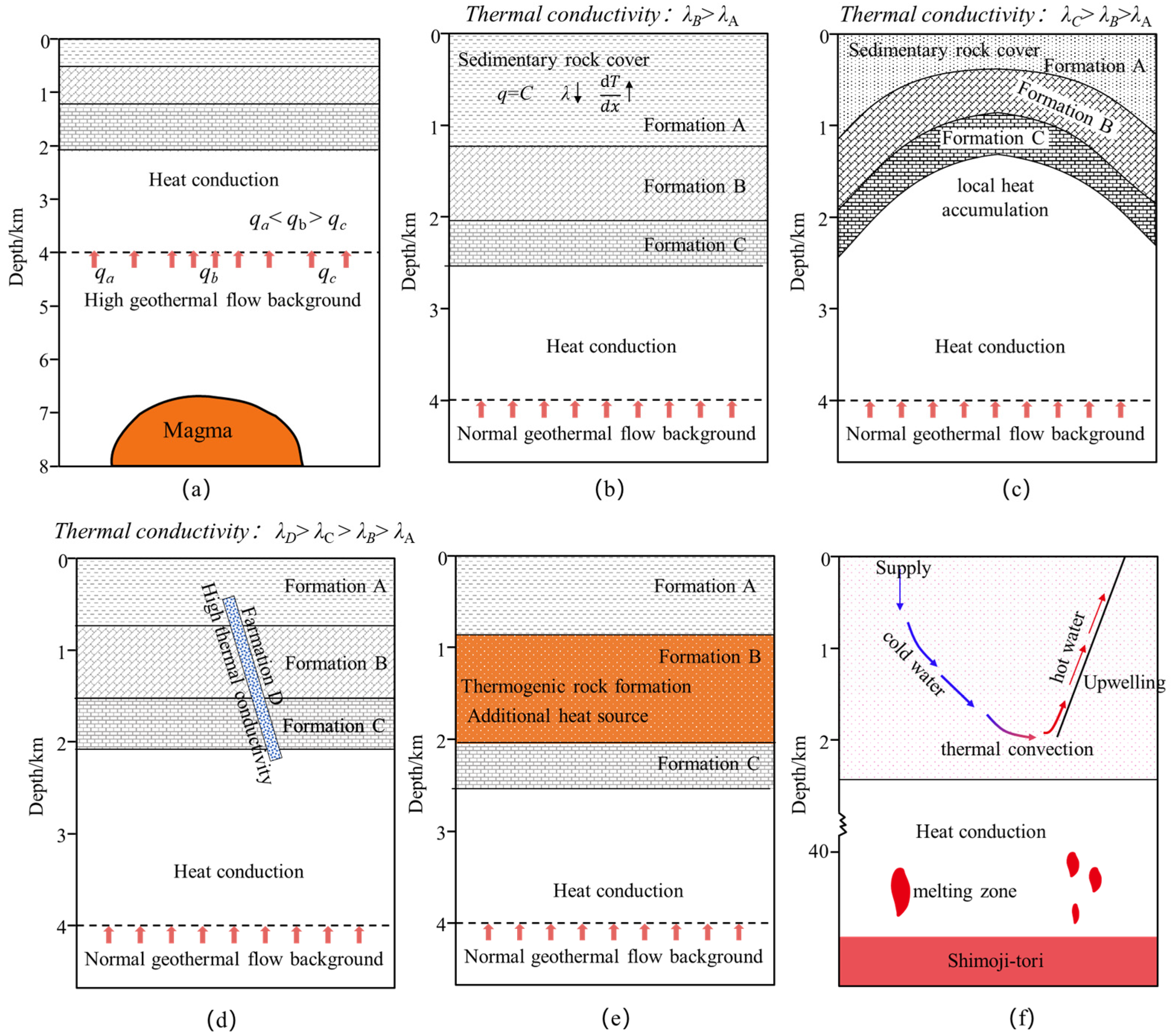
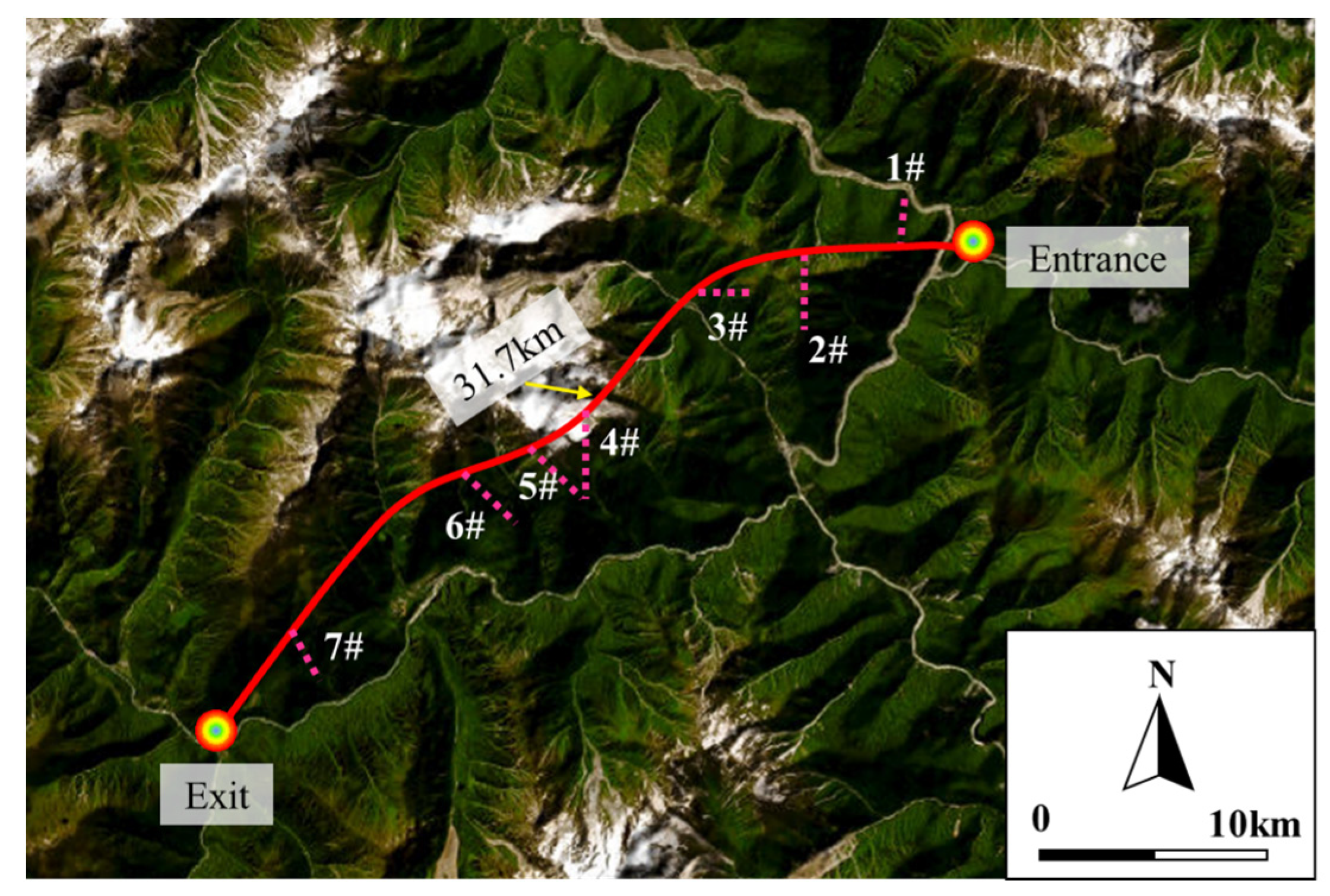
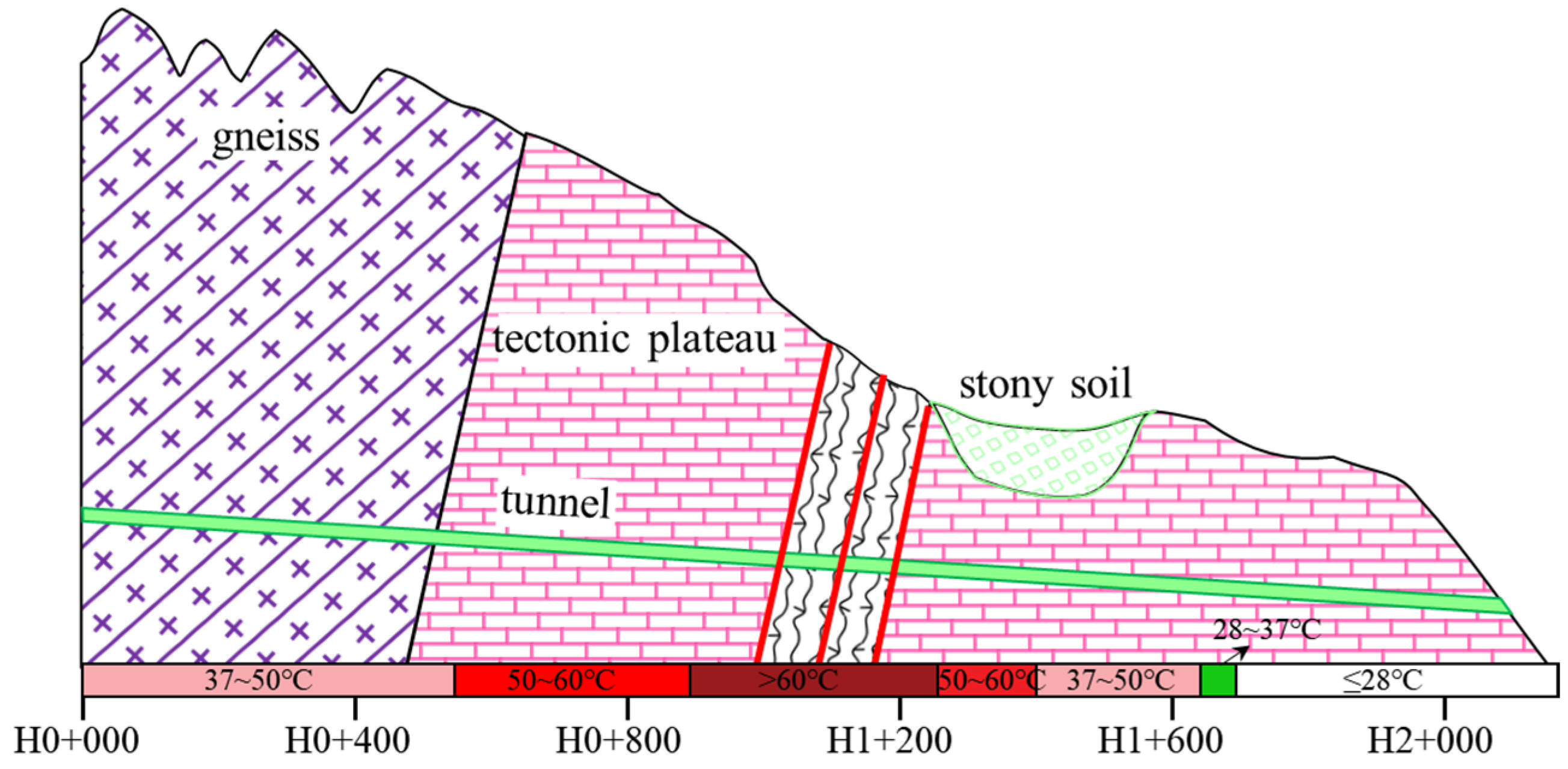

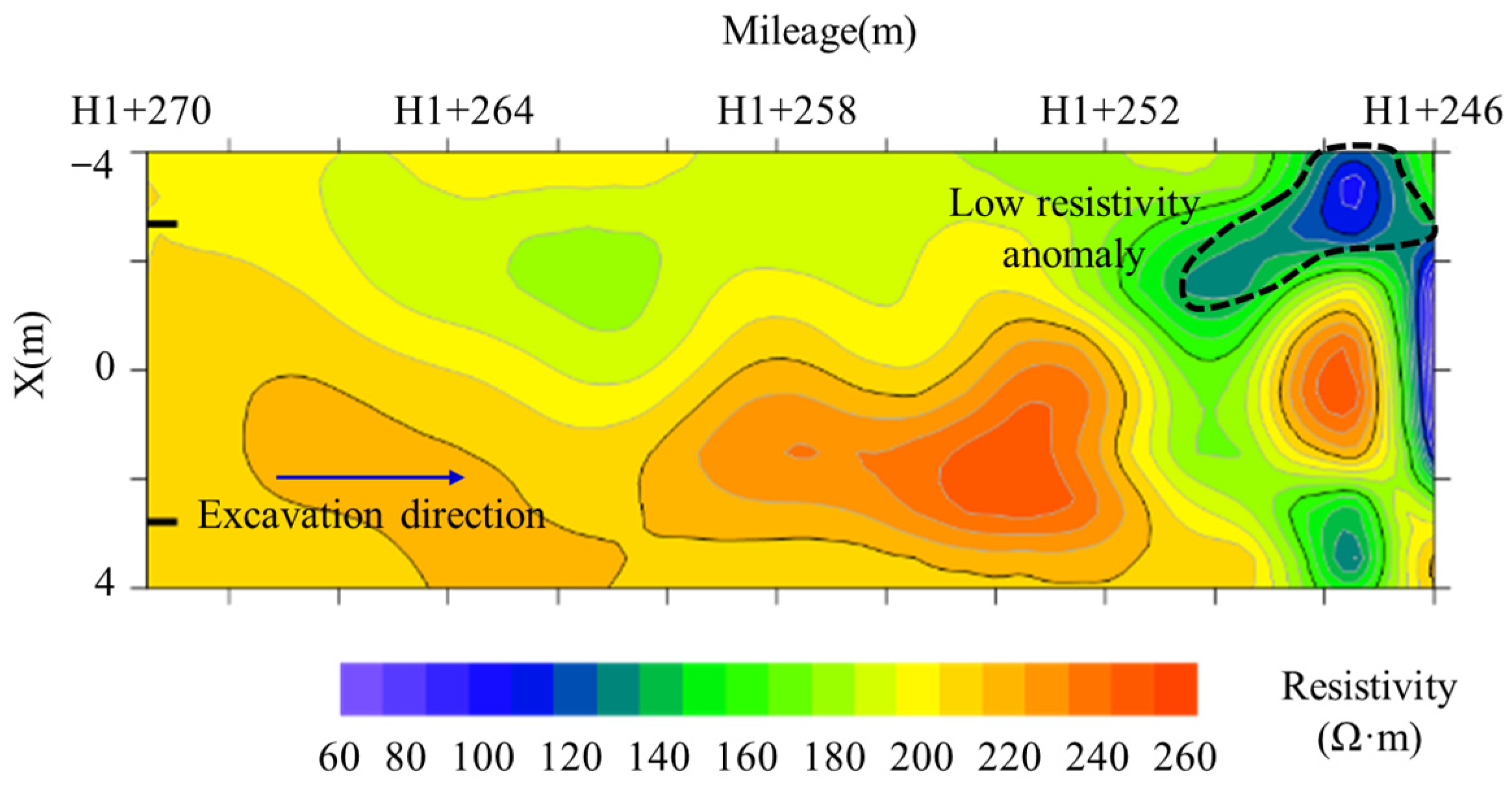
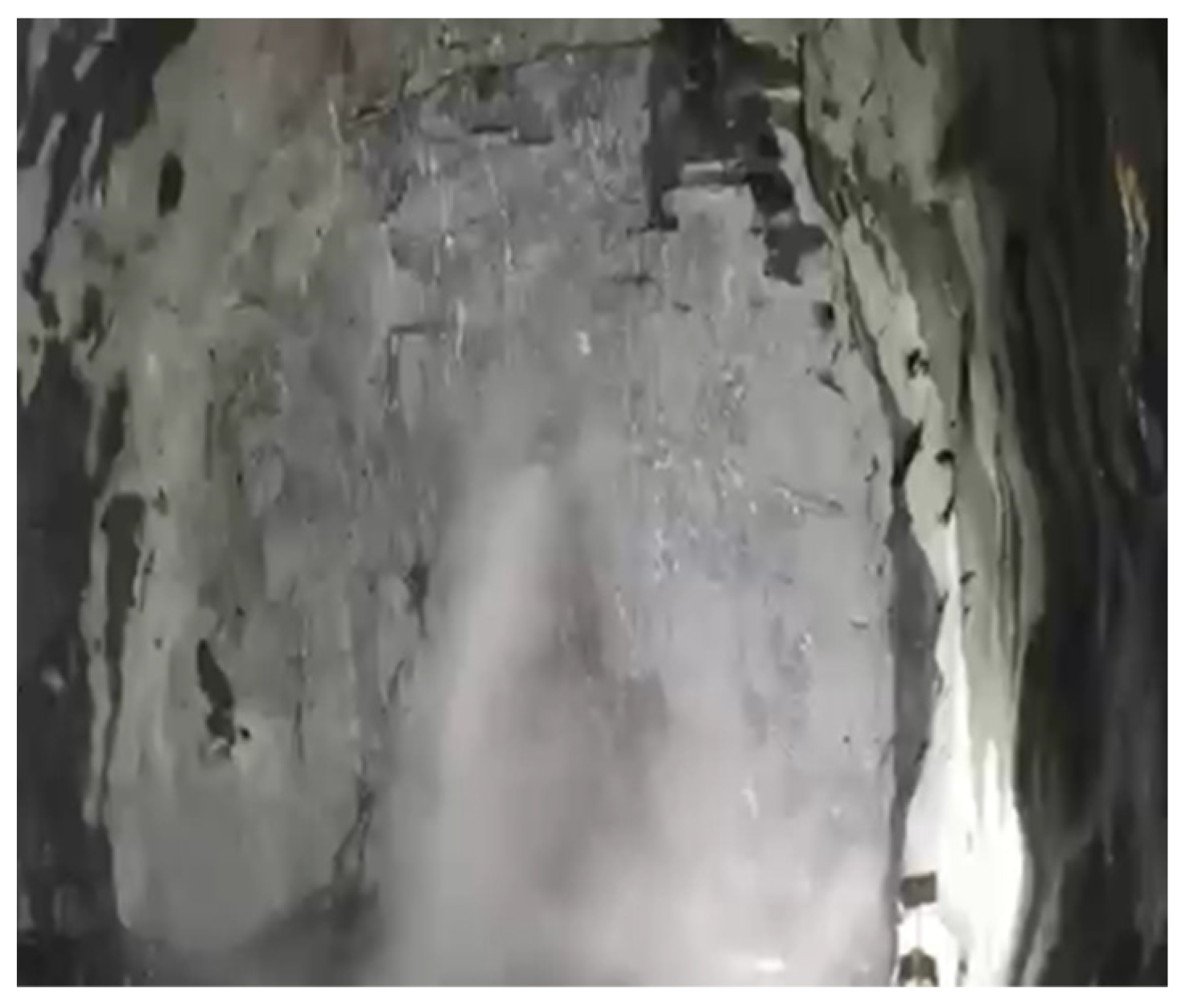
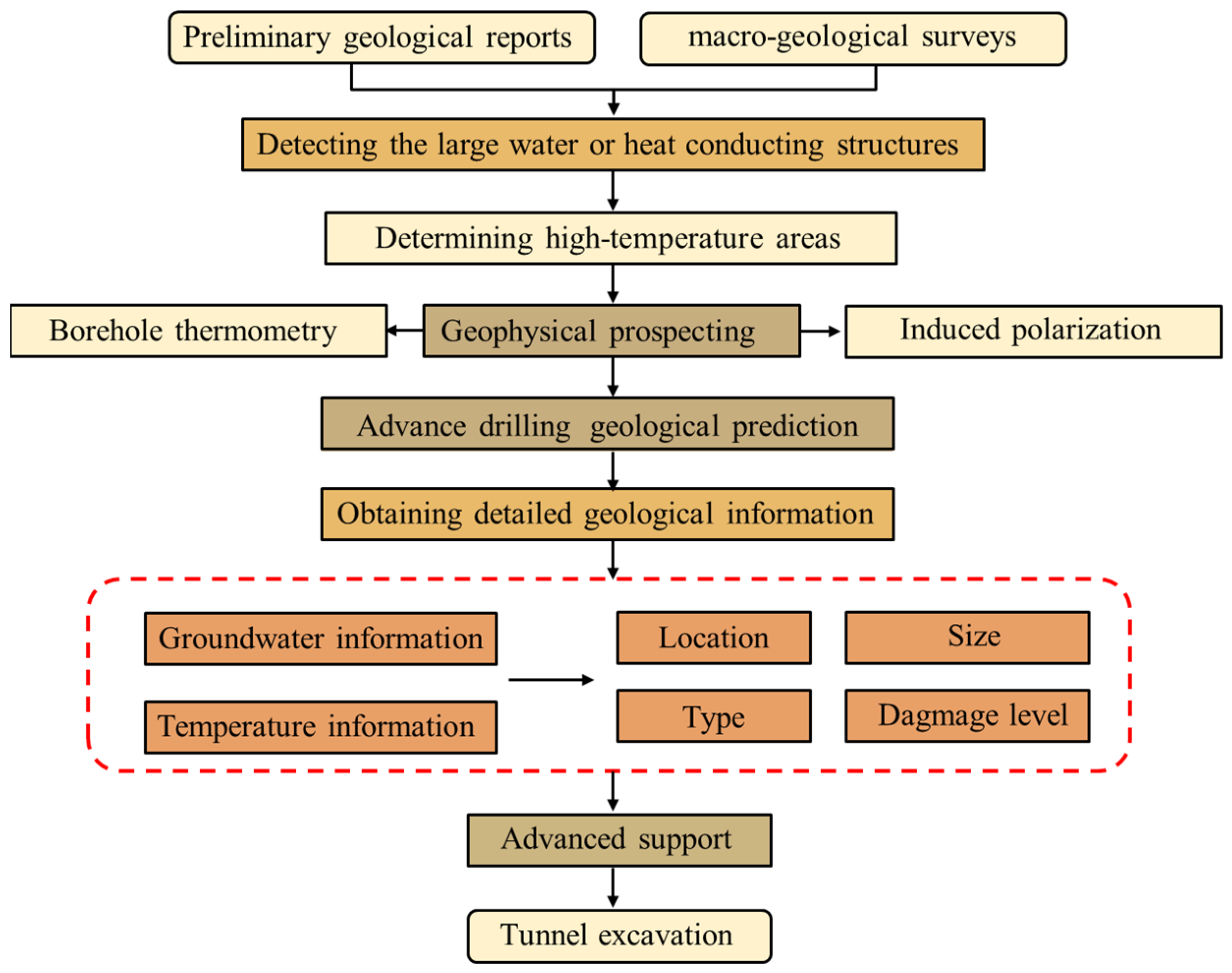
| Variable | Rock Formation | Thickness/m | Thermal Conductivity λ W/(m·°C) | Geothermal Flow q mW/m2 | |
|---|---|---|---|---|---|
| Case 1 | q | I | 1000 | 1.5 | 60 → 80 → 100 |
| II | 1000 | 2 | |||
| Case 2 | λI | I | 1000 | 2.5 → 2 → 1.5 | 60 |
| II | 1000 | 3 |
| Targets of Disasters | Forms of Disasters |
|---|---|
| Tunnel environment | Damage to physical and mental health of workers |
| Elevated risk of machinery and equipment failures | |
| Reduce labor efficiency of workers | |
| Surrounding rocks | Worsen the deformation of soft rock |
| Affect the rock explosion process in hard rock | |
| Increase safety risks associated with blasting operations | |
| Support structure | Reduce the anchoring force of anchor rods (ropes) |
| Deteriorate the mechanical properties of concrete | |
| Result in lining cracking | |
| Geologic disaster | Heighten the risk of incidents such as hot water inrushes, gas explosions, and landslides |
| Heat Hazard Type | Specific Classification | Characteristics |
|---|---|---|
| Deep-source high-heat type | — | In regions characterized by high-heat-flow backgrounds, the presence of deep-seated high-temperature sources results in elevated temperatures and heat flow within the shallow layers of the Earth’s crust (Figure 5a). |
| Localized heat gathering type | High thermal resistance rock cover subtype | In areas with a normal regional geothermal background, tunnels situated beneath a thick sedimentary cap layer experience high temperatures and steep geothermal gradients due to the high thermal resistance of the cap layer (Figure 5b). |
| Bedrock uplift subtype | Within regions featuring a normal regional geothermal background, the presence of positive geological structures, characterized by lower thermal resistance compared to surrounding bedrock structures, leads to heat accumulation in these areas, resulting in elevated temperatures and increased heat flow (Figure 5c). | |
| High thermal conductivity rock belt subtype | In locations characterized by the normal regional geothermal background, the presence of rocks with significantly high thermal conductivity in the tunnel’s surroundings results in the formation of a high thermal conductivity rock zone. This, in turn, causes heat accumulation, resulting in elevated temperatures and increased heat flow (Figure 5d). | |
| Additional heat source type | High heat-producing rock subtype | Under specific geological conditions, the presence of rock layers at the depth of tunnel rich in heat-generating elements acts as an additional heat source. This factor influences the temperature field and becomes a significant contributor to tunnel temperature anomalies (Figure 5e). |
| Underground hot water circulation subtype | Tunnels located in the pressure discharge area of a significant groundwater basin or within the discharge zone of a groundwater circulation system in a major fault zone are primarily affected by the rising activity of hot water. It becomes the main factor causing tunnel heating. The tunnels are directly and indirectly affected by hot water, which manifests itself in high rock temperatures and high-temperature water inrushes, respectively (Figure 5f). |
Disclaimer/Publisher’s Note: The statements, opinions and data contained in all publications are solely those of the individual author(s) and contributor(s) and not of MDPI and/or the editor(s). MDPI and/or the editor(s) disclaim responsibility for any injury to people or property resulting from any ideas, methods, instructions or products referred to in the content. |
© 2024 by the authors. Licensee MDPI, Basel, Switzerland. This article is an open access article distributed under the terms and conditions of the Creative Commons Attribution (CC BY) license (https://creativecommons.org/licenses/by/4.0/).
Share and Cite
Wang, C.; Liu, Z.; Zhang, F.; Guo, Q.; Dong, Z.; Bai, P. Heat Hazards in High-Temperature Tunnels: Influencing Factors, Disaster Forms, the Geogenetic Model and a Case Study of a Tunnel in Southwest China. Sustainability 2024, 16, 1044. https://doi.org/10.3390/su16031044
Wang C, Liu Z, Zhang F, Guo Q, Dong Z, Bai P. Heat Hazards in High-Temperature Tunnels: Influencing Factors, Disaster Forms, the Geogenetic Model and a Case Study of a Tunnel in Southwest China. Sustainability. 2024; 16(3):1044. https://doi.org/10.3390/su16031044
Chicago/Turabian StyleWang, Chengkun, Zhengyu Liu, Fengkai Zhang, Qian Guo, Zhao Dong, and Peng Bai. 2024. "Heat Hazards in High-Temperature Tunnels: Influencing Factors, Disaster Forms, the Geogenetic Model and a Case Study of a Tunnel in Southwest China" Sustainability 16, no. 3: 1044. https://doi.org/10.3390/su16031044
APA StyleWang, C., Liu, Z., Zhang, F., Guo, Q., Dong, Z., & Bai, P. (2024). Heat Hazards in High-Temperature Tunnels: Influencing Factors, Disaster Forms, the Geogenetic Model and a Case Study of a Tunnel in Southwest China. Sustainability, 16(3), 1044. https://doi.org/10.3390/su16031044





